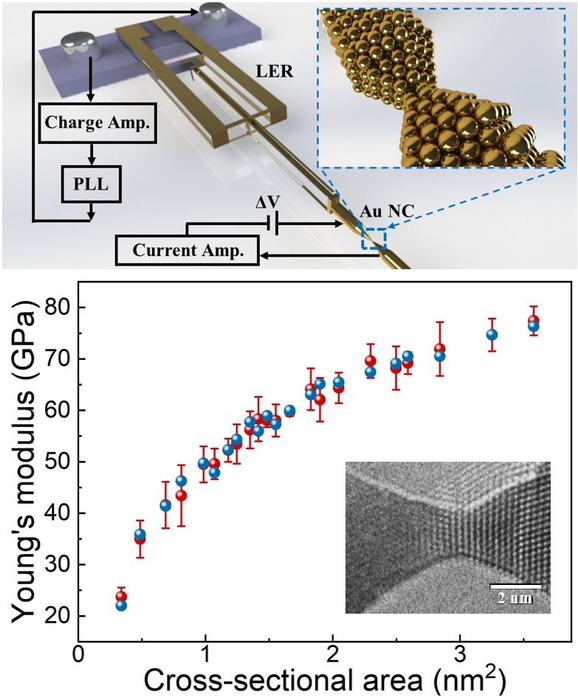Reviewed by Alex SmithApr 12 2022
Miniaturization is at the heart of several technological breakthroughs. It is obvious that as devices and their components become smaller, researchers can unleash new capabilities and create previously unimaginable applications.
 (Top) The nanomechanics measurement set-up. (Bottom) Young’s modulus of Au nanocontacts plotted as a function of cross-sectional area. Red circles represent experimental values and blue circles indicate results from first-principles calculations. (Inset) a typical TEM image of an Au nanocontact. Image Credit: Yoshifumi Oshima from JAIST.
(Top) The nanomechanics measurement set-up. (Bottom) Young’s modulus of Au nanocontacts plotted as a function of cross-sectional area. Red circles represent experimental values and blue circles indicate results from first-principles calculations. (Inset) a typical TEM image of an Au nanocontact. Image Credit: Yoshifumi Oshima from JAIST.
However, as more scientists investigate materials with atomic-scale structures, the gaps in the present knowledge of nanomaterial physics become increasingly apparent.
The surface of a nanomaterial is an example of a knowledge gap. This is because when a material’s surface-to-volume ratio is large, the impact of surface quantum phenomena becomes much more evident.
The fundamental properties of nanomaterials vary from their bulk counterparts when their size is decreased to a few atoms in nanoelectromechanical systems (NEMS), a current popular area in the study. For the advancement of this technology, a thorough understanding of the mechanical characteristics of nanowires and nanocontacts — essential components of NEMS — is required. Measuring them, on the other hand, has been difficult.
In this context, a Japanese research team has accomplished an unparalleled achievement by precisely measuring the elastic properties of gold nanocontacts pushed down to a few atoms. Professor Yoshifumi Oshima of the Japan Advanced Institute of Science and Technology (JAIST) conducted the work, which was published in Physical Review Letters.
Professor Masahiko Tomitori and postdoctoral research fellow Jiaqi Zhang from JAIST, as well as Professor Toyoko Arai of Kanazawa University, made up the rest of the group.
The researcher utilized transmission electron microscopy (TEM) in an ultrahigh vacuum to monitor the gold nanocontacts while they were mechanically strained. This was necessary to make sure that the nanocontacts’ surfaces remained spotless during the measurements. Meanwhile, the scientists used a previously discovered unique technique to correctly evaluate the nanocontacts’ Young’s modulus (a measure of stiffness).
They used a TEM holder to hold a quartz length-extension resonator (LER) and connected one side of the nanocontact to it. The resonant frequency in their configuration changed based on the gold nanocontact’s “equivalent spring constant,” which is linked to the material Young’s modulus.
With our approach, which we named the ‘nanomechanics measurement method,’ we can accurately measure a nanomaterial’s equivalent spring constant while simultaneously observing it using TEM and measuring its electrical conductivity.
Yoshifumi Oshima, Professor, Japan Advanced Institute of Science and Technology
The researchers used this method to experiment with gold nanocontacts that were gradually stretched without breaking. They measured how Young’s modulus altered when each nanocontact was stretched and witnessed how individual atoms reorganized themselves into new layers. Young’s modulus of the inside of the nanocontacts was equivalent to that of bulk gold (90 GPa), yet Young’s modulus of the nanocontacts’ surface was only 22 GPa.
The researchers used this information to show that the softness of gold nanocontacts’ outermost surface layer determines their total strength.
Our findings clarify why the strength of a nanomaterial differs from that of bulk crystals depending on its size, and our approach allows us to estimate Young’s modulus of any type of nanosized gold. Most notably, our results provide appropriate guidelines for the design and development of nanowires and nanosheets for NEMS. This could open doors to promising pressure, gas, and sound sensors, among other applications.
Yoshifumi Oshima, Professor, Japan Advanced Institute of Science and Technology
Aside from NEMS, the researchers predict that their findings, along with their measurement method, could have ramifications for chemistry. This is because atomic-scale vibrations on the catalyst’s surface, as well as the structure and electronic state of the catalyst, influence chemical reactions. Since these atomic vibrations are associated with the material’s surface strength, the presented method could aid in the discovery of new chemical reaction control methods.
However, there is a hope that future research will improve the understanding of nanomaterials even further.
Journal Reference:
Zhang, J., et al. (2022) Surface Effect on Young’s Modulus of Sub-Two-Nanometer Gold [111] Nanocontacts. Physical Review Letters. doi.org/10.1103/PhysRevLett.128.146101.